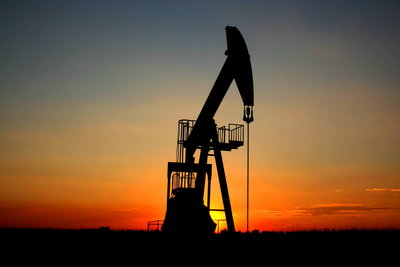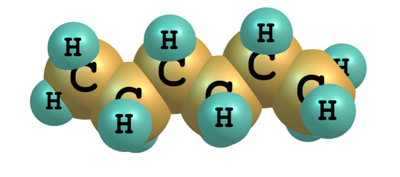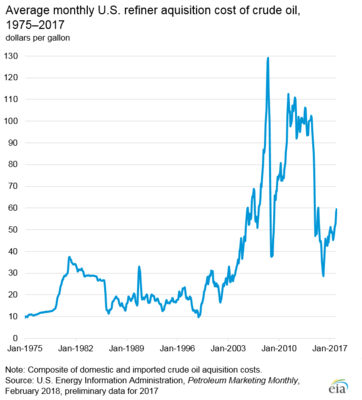Crude Oil
Introduction

Crude Oil Pump
Crude oil is oil that is not yet refined to produce useful products. It consists of a mixture of a wide variety of chemicals, most of which are hydrocarbons. Hydrocarbons are compounds formed from carbon and hydrogen atoms that combine in a multitude of ways to create gases, liquids and solids. These mixtures of various hydrocarbons exist underground in porous deposits known as reservoirs, embedded in sedimentary rocks, and in tar (oil) sands close to the surface of the earth.
Besides hydrocarbons, crude oil also contains a number of other components, some of which are potentially economically useful, while others can be harmful to humans or damaging to the environment. These components can be sulfur compounds, free hydrogen, nitrogen compounds, and a variety of high-density, solid hydrocarbons. An analysis of the characteristics of any particular grade of crude is reported in an "assay", which is a listing of the chemical components and physical properties comprising the crude oil, and which determines its quality and value. Assays can vary widely in the measurements of the components listed, often depending on the field from which the oil was extracted.
Hydrocarbons

Hexane
The main constituents of all oil deposits are hydrocarbons, consisting of carbon and hydrogen, bonded to form compounds of varying sizes, configurations and physical properties. It is hydrocarbons that make oil-based fuels most useful and valuable, since they can be burned to yield energy that powers large segments of our modern civilization, including cars, factories and the systems that heat our homes.
Hydrocarbons can range in composition from methane, a very simple gaseous compound that is the main constituent of natural gas, through light liquids that form most of crude oil, to dense heavier liquids, and finally to complex, solid hydrocarbons that are present in both crude oil and in coal. However, within each of these fossil fuel categories (natural gas, oil, coal) is a wide range and mixture of hydrocarbon compounds that can potentially span from gases to solids.
The refining of crude oil will usually lead to production of some gaseous and solid products, as well as the liquids that constitute most of its composition. The physical state of many of these compounds depends on the temperature and pressure at which they are refined. At normal temperature and pressure, hydrocarbon compounds with 1-4 carbon atoms are gases; those with 5-24 carbon atoms are liquids; and most hydrocarbon compounds with 25 or more carbon atoms are solids.
Unconventional Crude
Unconventional Crude Oil is oil that must undergo special treatment, before it can be sent to a refinery where conventional crude oil is processed. Unconventional crude usually comes from sources that have not, in the past, been economical for mining purposes. However, modern techniques for extracting crude oil from unconventional sources, together with depletion of conventional oil resources, can make unconventional crude an important source for petroleum products. The most common sources for unconventional crude oil are oil sands, coal-based syncrude, and shale oil.
Assays
An important step in assessing the value and usefulness of any shipment of crude oil is an assay. An assay is a report on the properties of crude oil that helps determine what can be derived from it in the refining process. Several tests are performed on multiple features of crude oil samples. These tests are evaluated and compiled into the assay, and then the assay is used as a guide in determining what must be done to convert the crude oil into commercially viable products.
The most important property of crude oil in determining its value and usefulness, and a critical part of any assay, is its density. Heavy, dense oil usually consists mostly of large, long-chain hydrocarbons, which are often either solids or highly viscous liquids. Heavy oils are ill-suited for purposes that require lighter, less viscous, liquid hydrocarbons such as gasoline, diesel fuel, and jet fuel. The lighter hydrocarbons are the most in demand and, thus, the most valuable.
The U.S. Department of Energy has published a manual, the "Strategic Petroleum Reserve Crude Oil Assay Manual", that defines the criteria and procedures for assessing the quality of crude oil to be acquired for storage in the U.S. Strategic Petroleum Reserve (SPR). This manual provides an overall review of what constitutes an assay of crude oil and is a thorough reference for the possible compounds and elements that may be found in various grades of crude oil.
Crude Contaminants
Often there are contaminants in crude oil that lower its value for various reasons. One of the most important of these components is sulfur, which reduces the energy content of oil, corrodes the metal piping within which crude oil flows and the metal tanks in which it is stored. In addition, sulfur creates a "rotten egg" smell, which must be removed in the refining process.
Other contaminants include various acids produced by bacterial biodegradation of crude oil, which, like sulfur, corrodes metal pipes and tanks. In addition, nitrogen and salt, if present, can lead to pipe and tank corrosion.
